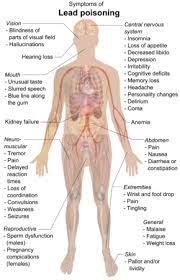Lead Poisoning:

High levels of lead were found in the blood of thousands of children living around the Kabwe mine in Zambia.
- Lead poisoning or chronic intoxication is caused by the absorption of Lead in the system and is characterised especially by fatigue, abdominal pain, nausea, diarrhoea, loss of appetite, anaemia, a dark line along the gums, and muscle paralysis or weakness of limbs.
- Children younger than 6 years are especially vulnerable to lead poisoning, which can severely affect mental and physical development.
- At very high levels, lead poisoning can be fatal.
- Lead exposure also causes anaemia, hypertension, renal impairment, immunotoxicity and toxicity to the reproductive organs.
- More than three quarters of global lead consumption is for the manufacture of lead-acid batteries for motor vehicles.
- People can become exposed to lead through occupational and environmental sources.
- This mainly results from:
- Inhalation of lead particles generated by burning materials containing lead, for example during smelting, recycling, stripping leaded paint and using leaded aviation fuel, and
- Ingestion of lead-contaminated dust, water (from leaded pipes) and food (from lead-glazed or lead-soldered containers).
Lead:
- Lead is a naturally occurring toxic metal found in the Earth’s crust.
- Lead in the body is distributed to the brain, liver, kidney and bones.
- It is stored in the teeth and bones, where it accumulates over time.
- Human exposure is usually assessed through the measurement of lead in blood.
- Lead in bone is released into blood during pregnancy and becomes a source of exposure to the developing foetus.
- There is no level of exposure to lead that is known to be without harmful effects.
- Lead exposure is preventable.
- According to the Institute for Health Metrics and Evaluation (IHME), in 2019, lead exposure accounted for 900 000 deaths and 21.7 million years of healthy life lost (Disability-Adjusted Life Years, or DALYs) worldwide due to long-term effects on health.
- The highest burden was in low- and middle-income countries.




